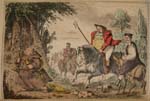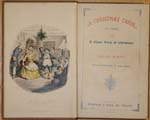John Leech
An excellent caricaturist, John Leech (1817-1864)'s style is very different from that of either Rowlandson or George Cruikshank, and has been described in such unlikely terms as "pure" and "wholesome" (Hardie 205). Leech is perhaps most famous for his drawings for Punch, the British humor magazine, for which he began working in August 1841, just after the first issue appeared, and for which he supplied over 3,000 illustrations. Some consider that Leech did his best work outside books, often for Punch, where he created many characters that were instantly recognizable to the Victorian public.
Leech was the son of the proprietor of the London Coffee House, and grew up in an atmosphere of sociability, debate, and politics. He originally studied medicine but never became a doctor. He did, however, study art in France, an unusual step for an illustrator of his generation, and one which may account for his turn from the more ruthless caricature of the Regency period to the new satire of the comédie humaine (humane comedy), which was popular on the continent.
Leech illustrated numerous books, including many that do not qualify as color plate books. Many of his book illustrations were for second-tier authors; the Robert Surtees sporting books and the Charles Dickens Christmas books are exceptions.

Leech illustrated a number of books by Surtees, although in Ask Mamma the sporting interest is subservient to a broader picture of provincial English society. Like many of Surtees's novels, Ask Mamma has no strong central character holding the narrative together, although many of its characters are memorable. Surtees himself warned readers in the Preface that "the following story does not involve the complication of a plot."

It is often said that Surtees's novels were not particularly popular until Leech began to illustrate them, although that idea has recently been disputed. It is certain, however, that Leech's illustrations add wit and flair to Surtees books. Plain or Ringlets is another novel of provincial England, with only a glancing sporting interest.

This book was a collaboration between Leech and a fellow Punch staffer, the writer Gilbert A'Beckett. The text is full of puns and humor, and Leech finds ample room for satire and humor in the follies and foibles of history. He seems especially drawn to royal personages, as shown by the image of Henry VIII "monk hunting" at left. In addition to the colored plates, numerous black and white wood engravings appear throughout the text.

This companion volume to the Comic History of England is also full of humor. Leech's drawings are somewhat anachronistic in terms of style and dress, but are nevertheless amusing.

Leech's drawings for A Christmas Carol are often considered the most enduring of the many illustrations that have been done over the years for this book, and they are among his best work as a book illustrator. Leech would also provide illustrations for Dickens's later Christmas books, but none of these were done in color, and none proved as successful, either in story or illustration, as A Christmas Carol.
